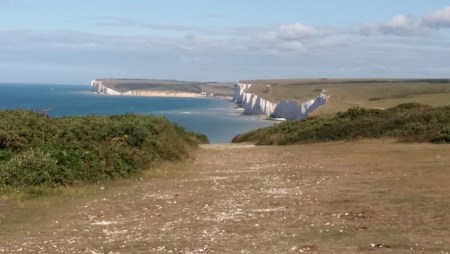After encountering a reference in a review, I ended up reading a lot about Scottish writer Kathleen Jamie. To my shame, I’d not read her books before, although I’ve since picked up Findings on the Kindle. What attracted to me about Jamie was her aggressive critique of nature writing, particularly how it relates to class and gender.
Considering such things is not just virtue signalling on my part; and any responses need to go beyond writers just acknowledging their privilege. I think there is a deeper question about how people from comfortable backgrounds justify their writing (in the same way that many writers from minorities might feel forced to as a matter of course).
I’ve been thinking about this in relation to my writing about the South Downs Way. It’s not simply about being ‘better’, which reinforces the idea of writing as a competition for scarce audiences. For me, it is about being aware of what makes my writing worth showing to anyone else. If I simply write from a position of privilege, I am merely a ventriloquist for society. Instead, I need to ask what I can say that nobody else can, and make sure I am doing that.
Jamie wrote in her 2008 LRB essay:
What’s that coming over the hill? A white, middle-class Englishman! A Lone Enraptured Male! … Here to boldly go, “discovering”, then quelling our harsh and lovely and sometimes difficult land with his civilised lyrical words.
Jamie is not fond of nature writing, saying in one interview “ I can’t even say the words ‘nature writers’, I can’t get it out of my gob … “. In an New Statesman piece, Death of the naturalist: why is the “new nature writing” so tame?, Mark Cocker linked Jamie to another writer, Jim Perrin, who
argues that new nature writing is quintessentially an urban literature with a primarily metropolitan audience. [Perrin] suggests that for both author and reader, engagement with nature is an act of remembrance rather than a daily, lived experience. Given that most Britons now dwell in cities, one could argue that it is therefore a perfect literature for our times.
As Cocker continues, this literature often involves:
clothing a landscape in fine writing, both the writer’s own and that of other historical figures… John Crace’s mischievous “Digested Read” for the Guardian of Macfarlane’s latest book, Landmarks, defines “Macfarlish” as “the process of praising other authors to make your own book better by association”
In a 2019 Guardian interview, Jamie talked about how “has been colonised – by middle-class white men“, suggesting that “if you understand how that’s happened, you understand the whole godforsaken political state of this country.” The same type of people as usual have emerged at the top of a field that Jamie says was “barely there” 15 years ago. The same calm competence ends up running things again.
One of the assumptions this leads to is the idea of ‘the wild’. This means different things to different people, depending on how secure they feel, their sense of safety, and, yes, their financial background:
There’s nothing wild in this country: every square inch of it is ‘owned’, much has seen centuries of bitter dispute; the whole landscape is man-made, deforested, drained, burned for grouse moor, long cleared of its peasants or abandoned by them…
James also points out that our relationship to the wild has changed because
with our (almost) guaranteed food supplies, motor engines, vaccines and antibiotics, [we] have begun to make our peace with these wild places, and to seek recreation in land which was once out to kill us, where we can be reassured, in some way
These points raised by Jamie link in with the issues raised by Angus Carlyle when he was interviewed on Justin Hopper’s Uncanny Landscapes Podcast. Where does the authority and competence of these writers come from. Kathleen Jamie describes our interaction with this figure:
The danger of this writing style is that there will be an awful lot of ‘I’. If there is a lot of ‘I’ … then it won’t be the wild places we behold, but the author. We see him swimming, climbing, looking, feeling, hearing, responding, being sensitive, and because almost no one else speaks, this begins to feel like an appropriation, as if the land has been taken from us and offered back, in a different language and tone and attitude. Because it’s land we’re talking about, this leads to an unfortunate sense that we’re in the company, however engaging, of another ‘owner’, or if not an owner, certainly a single mediator.
There is an important question here about how I write about the world around me. How can I move beyond an assumption of universality? How do I move beyond simply explaining, particularly when that act of explaining often masks an act of appropriation? How do I introduce a space for doubt, for appreciating the beautiful spectrum of approaches other people will bring to a natural space? I think there is a space to talk about my experience of landscapes, but I guess the question is how to do that without assuming that my subjective experience is everything.




































